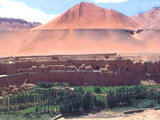
Xinjiang Uygur Autonomous Region is striving to rejuvenate the past glory of the ancient Silk Road, and become a centre for trade and economic cooperation linking China with countries in Central and West Asia.
China's western development campaign and the plan to enhance economic cooperation among member countries of the Shanghai Cooperation Organization (SCO) offer great opportunities for the region to develop its economy, local officials said.
"Xinjiang boasts abundant natural resources and its unique geographic position will help expand trade with neighboring countries and increase economic cooperation with eastern provinces," said Zhang Ye, deputy director of the region's Foreign Trade and Economic Cooperation Department.
"The success of the Urumqi trade fair has demonstrated the important role Xinjiang plays in China's relations with Central Asia," he said at a press conference organized by the region's information office on September 8.
The 12th China Urumqi Foreign Economic Relations and Trade Fair, held in the region's capital city, concluded with ample yields earlier this month.
The total volume of foreign trade is reported to have reached US$2.15 billion, 44 percent more than last year, and domestic business volume amounted to 51.2 billion yuan (US$6.17 billion) with a 64 percent increase.
More than 80 percent of foreign business people at the fair were from Kazakhstan, Tajikistan and other Central Asian countries, as well as the Asian areas of Russia.
Northwest China's Xinjiang occupies an area of over 1.66 million square kilometers, accounting for one-sixth of the country's territory, and it has a land border of 5,600 kilometers bounded by the eight countries of Mongolia, Russia, Kazakhstan, Kyrgyzstan, Tajikistan, Afghanistan, Pakistan and India.
The region is rich in resources like thermal power, petroleum and natural gas. Crude oil output, which reached 20 million tons last year, was the third highest in the country. Its reserves of mineral resources, namely beryllium, copper and mica, are the highest in China. And it is now the country's biggest production base for cotton, food industry-use tomatoes and Chinese wolfberries.
The completion of the new Eurasian Land Bridge, a rail line which runs through the two continents, in the early 1990s has made Xinjiang a threshold connecting China with countries to its west. At present, there are 14 frontier ports open in the region.
And according to statistics from the customs administration in Urumqi, the region registered US$2.57 billion in foreign trade in the first eight months of the year, up 74 percent from the same period last year, which is 37.7 percentage points more than the national average.
Trade volume with Kazakhstan alone amounted to US$1.37 billion in this period, or 79.6 percent up year on year.
Soaring small border trade and general trade were the two main factors behind the region's sharp foreign trade growth, according to a local customs spokesman.
As a hinterland region, Xinjiang has benefited substantially from the country's western development campaign, which was launched in 1999.
The central government has invested 77 billion yuan (US$9.28 billion) for 20 large projects of infrastructure construction in Xinjiang in the past three years.
At present, there are five new airports under construction. The roads in use total 57,700 kilometers in length. Three major rail lines run through the entire region. Investment in other infrastructure construction like telecommunications and power supply has also increased greatly.
Along with rich resources and favorable investment policies, the improvement in infrastructure facilities has made Xinjiang more competitive in attracting investment.
And as China enhances economic cooperation with the other countries of the SCO, namely Kazakhstan, Kyrgyzstan, Russia, Tajikistan and Uzbekistan, Xinjiang sees a brighter future in developing foreign trade and economic cooperation.
What's more, Xinjiang and the country's eastern provinces are enjoying good prospects for cooperation as they are mutually complementary in economy.
Currently, Xinjiang still falls behind eastern provinces in economic development. And it is impossible for Xinjiang to be a good international trader without support from the enormous domestic market.
"Enterprises from the developed coastal regions are invited to participate in the reform of Xinjiang's State-owned enterprises and tap Xinjiang's advantageous resources," said Zhang Zhou, vice-chairman of the autonomous region.
"We also offer a stage for development to other countries in Central and Western Asia."
(China Daily September 30, 2003)
|

